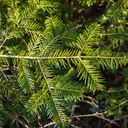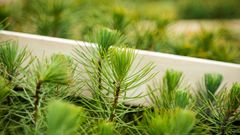

The genus Abies, found throughout the Northern Hemisphere, has more than 40 species. The Silver Fir (Abies alba ) is the primary resinous species of the central and southern European mountain ranges. About 70% of Silver Fir trees grow in altitudes between 600 and 1,200 meters.
The Silver Fir is resistant to wind and cold and indifferent to the chemical richness of its soil. This species also has two other advantages: it's a thermophilic species, able to germinate with only 1% light, and can be widespread to ensure its renewal.
In addition, Silver Fir is a melliferous plant that doesn't produce nectar, but honeydew: a substance rich in sugar, with little water. Bees use it along with pollen to make a honey rich in mineral salts. It is essential for bees, thus all biodiversity, hence why EcoTree chooses to plant it.
The Silver Fir is a thermophilic species, meaning it thrives in warm conditions. After the Yew tree, it's the most shade-tolerant tree, with its seeds capable of germinating with just 1% of daylight. When competing with taller, more dominant trees, a young Silver Fir can pause its growth for 100 to 200 years, patiently waiting for better conditions. However, it's sensitive to both early and late frosts, as well as drought.
Silver fir wood is white with a pink tint and popular for making framework and joinery products. The fir's wood is often overlooked in favour of spruce wood, as it's considered to be lower quality. However, it has excellent technological qualities and several other advantages over spruce. Its fecundity, durability, and weather resistance make it suitable for humid environments, such as in underground and hydraulic construction, and making glulam, windows, or saunas.
The flowers of the Silver Fir represent a lifted spirit, the spiritual ideal. This evergreen tree is a herald that encourages us to continue down our path, to endure life's problems as its branches endure the weight of snow. The tree symbolises the energy of resistance and the light of hope which it gives to those who know how to capture it. This makes it the ideal gift, a "good luck" gift, to bid courage and strength and, above all, to insist on never giving up halfway - regardless of the obstacles.
Gift a tree to convey your encouragement, gift a silver fir! An eco-friendly lucky charm!
Our goal is to enable anyone to do something that benefits nature and helps us to live in a more harmonious world. So why not become a tree owner in a European forest and help combat climate change?






Please note that this is promotional communication. See our notice of information.